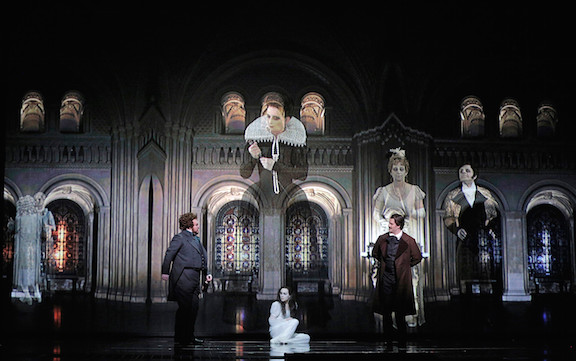
A double bill of horror and madness
Poe’s tale “The Fall of the House of Usher” has much in common with Henry James’ “The Turn of the Screw.” Offering near plotless stories, both tell of ghostly revelations and of a family tendency to perversion and morbidity. But perhaps even more closely, neither story explains with any lucidity what creates the emotional and physical collapse of the characters. Both stories depend on atmosphere and the psychological horror of confusion with its accompanying pain of innuendo and unbearable suggestion.
So what is their great attraction? Why are they seen as classics? To a much greater extent than most stories, they are all smoke and mirrors.
Can I suggest that their attraction lies in their ability to allow their readers to “rewrite” the story in their own imagination? Their unsolved mysteries nag and force the reader into supposition. Likewise, they allow the dramatist and opera composer to adapt them to serve their own purposes.
It is this adaptability, or changeability, if you like, that lies at the heart of San Francisco Opera’s co-production of Poe’s story, which opened last Tuesday. The evening was comprised of two composers’ and a production director’s interpretation of this moody, impressionistic tale of gothic horror. As such the performance maps out the eccentricities of creativity in the face of ambiguity.
The composers’ solutions were simple and the same: change the story. The director’s solution was simple also, and undoubtedly more costly: fill the moment with technological glamour. It was these comparative and contrasting solutions that gave the evening its fascination.
Gordon Getty chose to make the story a portrait of a family, devising a backstory for the actual house itself. Strange to say, the mansion is from Devon; just a hop, skip and a jump down the road from Cardiff, where the opera premiered in 2014. In Getty’s version, the House of Usher’s cursed walls have been shipped stone by stone to the New World.
Getty also adds a formal dance so that the character of Poe, who is visiting his ailing friend in his mansion, can meet the family, as it were. It’s a comic but chilling revelation of Roderick Usher’s failing mind. And indeed the family appears, projected in fantastic period costumes on the walls of the ballroom.
But perhaps the most radical change in the opera was the appearance of Doctor Primus, who is transformed from Poe’s terse description of Madeleine’s doctor as of “low cunning” to a figure of pure evil. A manipulator, who projects knowledge and the search for knowledge as a dark force right out of casual gaming.
The score was hampered by a wordy text that was set in seemingly endless recitative.
Although Debussy’s La Chute de la Maison Usher is a reconstruction by British composer and scholar Robert Orledge (he claims some 52% of the score as his own), it manages to effectively evoke Debussy and was more suitable for an atmospheric opera with passages of the wonderful lyric beauty so characteristic of the French composer. The opera opens with a woodwind solo over a heaving orchestra. Throughout the woodwinds were to die for.
The doctor in this version was also on the madcap side, with a cloud of vibrating red hair surrounding his pale face. Less a force of unmitigated evil, Le Médecin suggests a sexual source to the madness that corrupts the thin blood of the Usher twins. Madeleine is a vector for both the doctor and Roderick’s repressed desire.
Finally though it is Production Director David Pountney in concert with videographer David Haneke that carry the real aesthetic punch in the production. There is almost nothing on stage except the singers and three enormous screens across which are projected extraordinarily high-resolution films of Penrhyn Castle in Wales.
In Getty’s Usher House we swoop through the castle’s interior, passing through endless rooms, each grippingly three-dimensional, the whole providing a convincing illusion of a mansion given over to the stillness of time. In the Debussy, Haneke uses the castle’s stone exterior as the composer used petrification as a symbol for the family’s degeneration. The stonework is presented more abstractly, with massive columns, and the screens, rather than the images, move onstage, pushed by shadowy figures.
It’s been a dark and stormy season for Brian Mulligan, and he has sung it with an impressive emotional range and vocal élan, which includes his role as Roderick Usher. Adler Fellow Jacqueline Piccolino sang wonderfully as Lady Madeleine Usher, as did bass Anthony Reed, despite his long ghastly pale locks, in the role of Dr. Primus. Joel Sorensen inhabited the bizarre soul of Le Médecin. Tenor Jason Bridges was Edgar Allen Poe and baritone Edward Nelson was a sympathetic Ami. Jamielyn Duggan danced the role of Madeleine Usher in Getty’s opera. Lawrence Foster conducted.
– Jaime Robles
